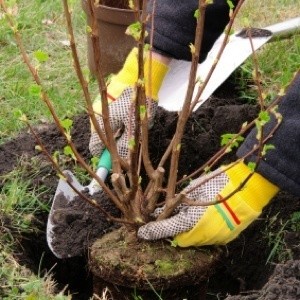
If you're thinking about adding some shrubs to your landscape, early fall is a great time for planting container-grown shrubs. The combination of warm soil and autumn rains encourages rapid root growth and cuts down on your need for watering. The nice thing about planting container-grown shrubs is that their rigid containers keep the roots well protected during transport. They also don't need to be planted right away. If life gets in the way after you bring them home, you can plant them a week or two later without doing any harm.
Start by doing your research. Choose shrubs that are suitable for your specific climate and soil conditions. Don't forget to factor in the shrub's potential height and spread to avoid having to dig it up and move it later.
When selecting your shrubs, look for plants with healthy foliage. Inspect them carefully for any signs of insect infestations or disease. Avoid plants that appear wilted or have noticeable spots, scars, or burns on their leaves. When possible, ask to inspect the root ball. Many people overlook this important step, only to be disappointed a year later when their shrub mysteriously dies.
Don't buy plants that have large roots growing through the bottom drainage holes, or those with so many roots coiled around the inside of the container you can barely see the soil ball. Purchasing root bound plants such as these amounts to paying for stunted growth.
To prepare the site, dig a hole that is at least 2 times wider and 1 1/2 times deeper than the shrub's root ball. Remove any rocks or debris and loosen up the sides and base of the hole with your shovel. Mix in equal parts of peat moss and compost with the excavated soil. This will provide the nutrients necessary to encourage the roots to expand out from the original root ball.
Water the shrub thoroughly. Once the water has been fully absorbed into the soil, tip the plant on its side and slip it out of its container. If necessary, use a pair of sheers or tin snips to cut open the sides. Gently tease the root ball (loosen up the soil around the roots) with your fingers. If a considerable amount of roots have entirely encircled the container, use a sharp knife to make four lengthwise cuts into the soil (1-inch deep) at even intervals around the root ball. This will prevent the large roots circling the root ball from girdling the shrub as it grows.
It is important to keep newly planted shrubs well watered going into autumn and during their first summer following planting. Water slowly and deeply, allowing the moisture to fully penetrate the soil down to the roots. Shrubs planted in the fall should not be fertilized for the first time until the following spring. Shrubs planted in the spring can be fertilized 8-10 weeks after planting.

About The Author: Ellen Brown is an environmental writer and photographer and the owner of Sustainable Media, an environmental media company that specializes in helping businesses and organizations promote eco-friendly products and services. Contact her on the web at http://www.sustainable-media.com
Add your voice! Click below to comment. ThriftyFun is powered by your wisdom!